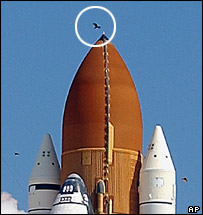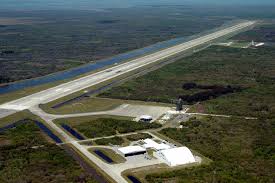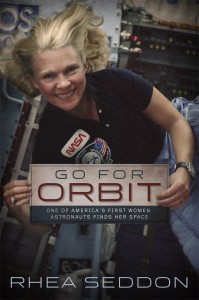Collisions
Our universe is vast—but that doesn’t mean things don’t run into each other.
Some say our moon was formed out of the debris from an Earth impact with a huge boulder named Theia. And later in Earth’s history, the dinosaurs and most life on our planet may have been destroyed by collision with an asteroid. On some dark nights, we can see meteors burning up as they enter our atmosphere.
It’s no surprise then that our spacecraft sometimes get dinged up by things running into them, sometimes with dire consequences. We get help avoiding close encounters in space through the vigilance of the Department of Defense which tracks space “junk,” mostly things left over from humans flinging things skyward. But sometimes the collisions happen before we get to space.
If you have been to a launch in Florida, you know that birds soar over the area. One day nearby cameras caught a picture of an unlucky turkey buzzard meeting a Space Shuttle coming off the launch pad.
After the landing of my first Shuttle flight, one of our forward-facing windows had a small dent in it. Analysis showed that it was caused by a tiny paint fleck we hit while on orbit. When a spacecraft is moving at 17,000 mph, even something that tiny can become a missile.
On my husband’s third Shuttle flight, STS-27, material from the nose cap of one of the boosters was seen hitting the Shuttle during lift-off. The crew could see some damage on the heat-shield tiles on the bottom of the vehicle using a camera on the robot arm, but the extent of the damage wasn’t verified until after landing. The crew was lucky that it wasn’t catastrophic – as it would be for the Columbia crew 15 years later.
In 1997, a supply vehicle slammed into the Russian Mir Space Station. It knocked a hole in one of the modules, air began leaking out, and the pressure inside started to drop. Luckily, the crew closed the bulkhead door, isolating the area, but it was a close call.
Even after the “space” part of the spaceflight, there was danger of collisions. The Kennedy Space Center in Florida is in the middle of a Wildlife Refuge. The Shuttle Landing Strip is out in the marshes near the ocean where water-filled canals run along the sides of the runway. NASA monitored the area near the runway carefully when a landing was planned. Prior to each Shuttle arrival, a special crew would drive a truck up and down the runway to scare away the birds, the deer – and even some slow-moving swamp creatures.
I guess if the Space Shuttle had run over a 500 pound alligator it would have added a new dimension to term “road kill.”
– Rhea
We’d love to add you to our email list.
If you have not yet signed up, please do so by clicking here.






Haha. I also suppose if a shuttle hit a gator on landing it could be the equivalent of cars hitting deer on highways and how things generally get totaled.